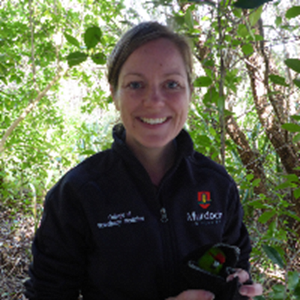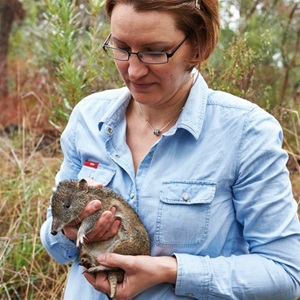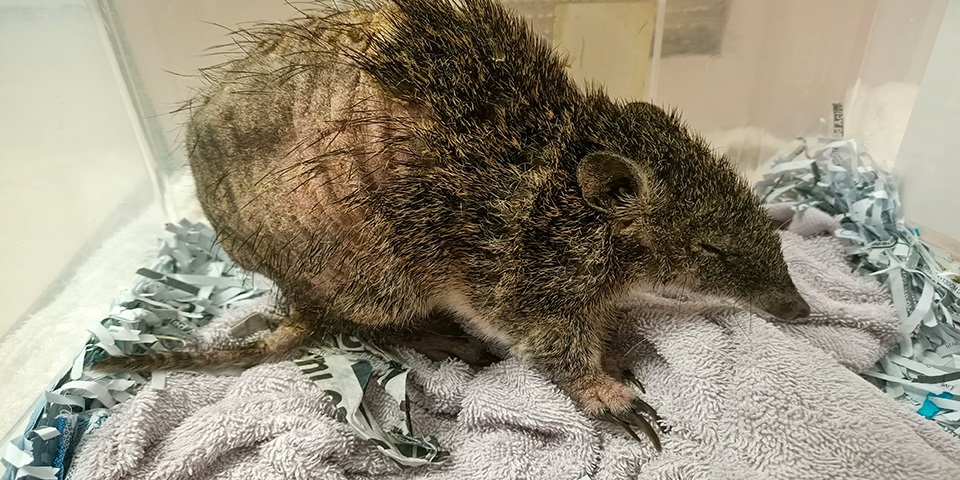Mange has been found in local quenda
Areas of research
Biosecurity
Lead researchers

Dr Bethany Jackson
Lecturer, Centre for Biosecurity and One Health, Harry Butler Institute, Murdoch University
View staff profile
Dr Amanda Ash
Senior Lecturer, Murdoch University, School of Medical, Molecular and Forensic Sciences
View staff profile
Dr Kate Bryant
Lecturer and Associate Dean Learning and Teaching, School of Environmental and Conservation Sciences
View staff profile
Over the last three years the Roleystone community and wildlife rehabilitation centres have become concerned over increasing numbers of the small marsupial seen with severe skin disease in local reserves and backyards.
Sarcoptic mange occurs when mites bury into and feed on the skin of a mammal. Although it is not common for the mite to be transmitted to people from wildlife, it can cause disease in pets and people. Further research is needed to understand how quenda become infected and what risk this poses to other species and to humans.
Once infected, quenda develop crusting of the skin, intense itchiness, and secondary complications that may lead to death. Even with treatment, Darling Range Wildlife Service reports 40 per cent of quenda will still require euthanasia due to the severity of the skin changes and complications.
Researchers conducted a study in winter 2022 to understand how the disease sarcoptic mange is manifesting in quenda in Roleystone urban and bushland sites.
The researchers aimed to capture quenda in urban and bush areas of Roleystone, collect samples, and determine how the mite impacts the skin and host, the best method for detecting the mite in this species, and how the mite found on quenda is related to other sarcoptid mites collected from hosts such as local foxes, and species in the east of Australia.
Interestingly, although quenda with mange were detected during the study in 2022, the majority of the approximately eighty quenda captured were in good body condition with normal appearing skin. However, captured quenda were from reserves adjacent to housing in the suburb, and during the study, quenda found in backyards with mange were submitted to local wildlife centres. The study did not detect quenda with mange from outside of the main area affected in prior research, however, there may be a link between sarcoptic mange and quenda that primarily live in urban backyards. Further research is needed to understand the link between backyards and sarcoptic mange in quenda, including whether quenda with mange move to these areas to access more food and resources as they become unwell, as well as the possibility that transmission of mange occurs at these backyard resources, such as sharing food or water from places like a pet food bowl.
Whilst mange continues to present in quenda, including the newer area of Jandakot and Coogee, due to the nature of the disease and the need for close contact, it is unlikely to spread rapidly beyond the two known regions affected. Roleystone has a particularly dense population of quenda with many resources available through urban backyards. This likely helps the disease transmit between quenda and other species, but also means they are overall a more abundant and healthy population due to more food and water availability. Given the incredible value of quenda in the landscape, including their ability to reduce fire impacts through digging and leaf litter redistribution, as well as improving soil quality, understanding the risk of sarcoptic mange to their conservation needs remains a priority for ongoing research
This work will help
to establish guidance on best management practices for individual
quenda, as well as expanding surveillance through local councils.
Project partners
City of Armadale
What you can do
Information on mange in native Australian species can be found on the Wildlife Health Australia website.
Funding
We are currently seeking funding for this project. If you are keen to help, please contact mange@murdoch.edu.au
Project Duration
2020 - ongoing
Read more about this work
Leah Botten, Amanda Ash, Bethany Jackson 2022 Characterising a sarcoptic mange epizootic in quenda (Isoodon fusciventer) International Journal for Parasitology: Parasites and Wildlife
https://www.murdoch.edu.au/news/articles/wildlife-community-comes-together-to-help-quenda-with-debilitating-skin-disease
Fact Sheets
Lead researchers

Dr Bethany Jackson
Lecturer, Centre for Biosecurity and One Health, Harry Butler Institute, Murdoch University
View staff profile
Dr Amanda Ash
Senior Lecturer, Murdoch University, School of Medical, Molecular and Forensic Sciences
View staff profile
Dr Kate Bryant
Lecturer and Associate Dean Learning and Teaching, School of Environmental and Conservation Sciences
View staff profileAreas of research
Biosecurity
Lead researchers

Dr Bethany Jackson
Lecturer, Centre for Biosecurity and One Health, Harry Butler Institute, Murdoch University
View staff profile
Dr Amanda Ash
Senior Lecturer, Murdoch University, School of Medical, Molecular and Forensic Sciences
View staff profile
Dr Kate Bryant
Lecturer and Associate Dean Learning and Teaching, School of Environmental and Conservation Sciences
View staff profile